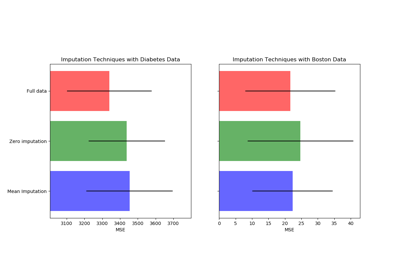sklearn.impute.MissingIndicator¶
-
class
sklearn.impute.MissingIndicator(missing_values=nan, features='missing-only', sparse='auto', error_on_new=True)[source]¶ Binary indicators for missing values.
Note that this component typically should not not be used in a vanilla
Pipelineconsisting of transformers and a classifier, but rather could be added using aFeatureUnionorColumnTransformer.Read more in the User Guide.
Parameters: - missing_values : number, string, np.nan (default) or None
The placeholder for the missing values. All occurrences of missing_values will be indicated (True in the output array), the other values will be marked as False.
- features : str, optional
Whether the imputer mask should represent all or a subset of features.
- If “missing-only” (default), the imputer mask will only represent features containing missing values during fit time.
- If “all”, the imputer mask will represent all features.
- sparse : boolean or “auto”, optional
Whether the imputer mask format should be sparse or dense.
- If “auto” (default), the imputer mask will be of same type as input.
- If True, the imputer mask will be a sparse matrix.
- If False, the imputer mask will be a numpy array.
- error_on_new : boolean, optional
If True (default), transform will raise an error when there are features with missing values in transform that have no missing values in fit. This is applicable only when
features="missing-only".
Attributes: - features_ : ndarray, shape (n_missing_features,) or (n_features,)
The features indices which will be returned when calling
transform. They are computed duringfit. Forfeatures='all', it is torange(n_features).
Examples
>>> import numpy as np >>> from sklearn.impute import MissingIndicator >>> X1 = np.array([[np.nan, 1, 3], ... [4, 0, np.nan], ... [8, 1, 0]]) >>> X2 = np.array([[5, 1, np.nan], ... [np.nan, 2, 3], ... [2, 4, 0]]) >>> indicator = MissingIndicator() >>> indicator.fit(X1) MissingIndicator(error_on_new=True, features='missing-only', missing_values=nan, sparse='auto') >>> X2_tr = indicator.transform(X2) >>> X2_tr array([[False, True], [ True, False], [False, False]])
Methods
fit(X[, y])Fit the transformer on X. fit_transform(X[, y])Generate missing values indicator for X. get_params([deep])Get parameters for this estimator. set_params(**params)Set the parameters of this estimator. transform(X)Generate missing values indicator for X. -
fit(X, y=None)[source]¶ Fit the transformer on X.
Parameters: - X : {array-like, sparse matrix}, shape (n_samples, n_features)
Input data, where
n_samplesis the number of samples andn_featuresis the number of features.
Returns: - self : object
Returns self.
-
fit_transform(X, y=None)[source]¶ Generate missing values indicator for X.
Parameters: - X : {array-like, sparse matrix}, shape (n_samples, n_features)
The input data to complete.
Returns: - Xt : {ndarray or sparse matrix}, shape (n_samples, n_features)
The missing indicator for input data. The data type of
Xtwill be boolean.
-
get_params(deep=True)[source]¶ Get parameters for this estimator.
Parameters: - deep : boolean, optional
If True, will return the parameters for this estimator and contained subobjects that are estimators.
Returns: - params : mapping of string to any
Parameter names mapped to their values.
-
set_params(**params)[source]¶ Set the parameters of this estimator.
The method works on simple estimators as well as on nested objects (such as pipelines). The latter have parameters of the form
<component>__<parameter>so that it’s possible to update each component of a nested object.Returns: - self
-
transform(X)[source]¶ Generate missing values indicator for X.
Parameters: - X : {array-like, sparse matrix}, shape (n_samples, n_features)
The input data to complete.
Returns: - Xt : {ndarray or sparse matrix}, shape (n_samples, n_features)
The missing indicator for input data. The data type of
Xtwill be boolean.


